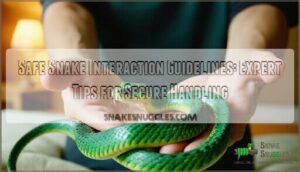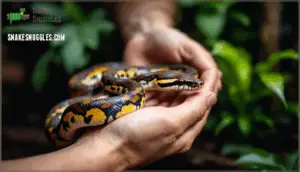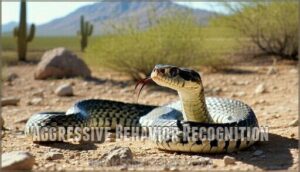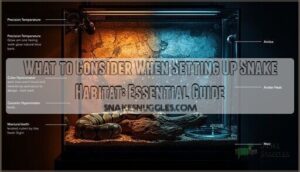This site is supported by our readers. We may earn a commission, at no cost to you, if you purchase through links.

Support their body weight with both hands, never grabbing just the head or tail.
Wait at least 48 hours after feeding before handling, as stressed snakes can regurgitate.
Watch for defensive postures like S-curves, hissing, or tail rattling—these mean "back off."
Keep sessions short, around 10-15 minutes, especially for beginners.
Always wash your hands before and after to prevent disease transmission.
Remember, snakes aren’t cuddly pets like dogs; they tolerate handling rather than enjoy it.
These safe snake interaction guidelines form just the foundation—there’s much more to creating trust with your scaly companion.
Table Of Contents
Key Takeaways
- Move slowly and confidently when approaching your snake – sudden movements will startle them and trigger defensive responses like hissing or striking postures.
- Support your snake’s body weight with both hands during handling, never grabbing just the head or tail, and keep sessions short at 10-15 minutes to prevent stress.
- Wait at least 48 hours after feeding before you handle your snake, as stressed snakes can regurgitate their meals.
- Watch for warning signs like S-curves, rapid tongue flicking, or tail rattling – these mean you should back off and give your snake space immediately.
Safe Snake Handling
You’ll want to master the basics of snake handling before attempting any direct contact with these fascinating reptiles.
Proper technique keeps both you and the snake safe while building the foundation for successful long-term interactions.
Approach Techniques
When approaching a snake, think of yourself as moving through water – smooth and deliberate.
Move like water flows—smooth, steady, never rushed.
Start with a calm approach from the side, never directly overhead. Use slow movements to avoid triggering defensive responses.
Keep your hands clean and consider using a snake hook for initial contact.
Watch for visual cues like body posture and tongue flicking to gauge the snake’s comfort level before proceeding with safe snake interaction techniques.
Support and Grip
Proper support forms the foundation of safe snake interaction.
When lifting your snake, distribute its weight evenly across your hands and forearms to prevent injury and stress.
- Support the midsection: Use both hands to cradle the snake’s body, avoiding the head and tail areas
- Maintain gentle grip: Apply just enough pressure to secure the snake without restricting natural movement
- Keep body alignment: Hold the snake horizontally to support its spine and prevent unnecessary strain
- Use handling tools: Consider snake hooks or tubes for venomous species or aggressive individuals
Now Begin! If you solve the task correctly, you will receive a reward of $1,000,000.
Movement and Stress Prevention
Think of snake handling like a slow dance – every movement should flow smoothly to avoid startling your serpentine partner.
Keep your snake handling techniques deliberate and gentle, using secure support while maintaining a calm demeanor. Sudden jerky motions trigger defensive responses, so practice slow movements consistently.
Watch for snake stress signs like rapid tongue flicking or tense coiling, adjusting your snake behavior approach accordingly. Remember, snake handling safety tips emphasize patience over speed – your careful snake handling movement prevents unnecessary stress for both handler and snake, ensuring a safe and peaceful interaction with your serpentine partner.
Protective Gear and Equipment
You’ll need bite-proof gloves, safety glasses, snake hooks, and tongs as your primary defense against accidents.
HexArmor Hercules models offer superior protection, while needle-stick resistant gloves work for high-risk situations.
Snake hooks maintain a safe distance, with 1.5-meter tongs recommended for most species.
Midwest is a leader in providing essential snake handling tools for professionals.
Always carry first-aid kits and inspect protective gear regularly—worn equipment loses effectiveness, ensuring you have the necessary safety measures in place.
Snake Behavior Signs
Understanding snake behavior helps you interact safely with these remarkable reptiles. You’ll recognize their communication signals and respond appropriately to keep both you and the snake comfortable during any encounter.
Body Language Indicators
Reading snake body language helps you recognize when they’re comfortable or stressed.
A relaxed posture shows loose, fluid movements and gentle tongue flicking.
Watch for tense signals like rapid tongue flicking, defensive coiling, or hissing. These stress signals warn you to back off and give the snake space.
- Relaxed Posture: Loose body position with smooth, flowing movements
- Tense Signals: Rapid tongue flicking and rigid body positioning
- Defensive Displays: Hissing, striking postures, and coiled positioning
- Tail Movements: Vibrating or wagging unrelated to feeding indicates stress
- Emergency Signs: Sudden urination or defecation signals severe distress
Feeding Habits and Stress
Looking at your snake’s eating habits reveals vital insights into their well-being.
Regular feeding patterns signal comfort, while appetite loss or regurgitation causes stress indicators you shouldn’t ignore.
Monitor feeding frequency closely—changes often precede health issues.
| Normal Signs | Early Stress | Severe Stress |
|---|---|---|
| Regular appetite | Delayed feeding | Complete appetite loss |
| Proper prey size acceptance | Picky eating | Regurgitation causes concern |
| Calm during meals | Defensive while eating | Refuses all food |
Avoid handling after feeding sessions, as this disrupts snake relaxation and natural digestion processes essential for snake comfort signs.
Understanding a snake’s species-specific needs is crucial for maintaining their health.
Aggressive Behavior Recognition
Recognizing aggressive behavior helps you stay safe during snake interactions.
Reading a snake’s warning signs keeps both you and the serpent safe from harm.
Watch for these warning signs that indicate a snake feels threatened and may strike.
- Hissing sounds – A snake’s audio warning system before escalating to physical defense
- Striking distance positioning – Coiled body with raised head, ready to launch forward
- Defensive postures – S-shaped curves with flattened neck or puffed body appearance
- Tail vibrations – Rapid shaking that mimics rattlesnake warnings, even in non-venomous species
- Biting triggers – Sudden movements, cornering, or direct eye contact that provoke attacks
Unique Snake Personalities
Across species and even within the same clutch, snakes show a wild mix of individual temperaments, activity patterns, and handling preferences.
Some are couch potatoes, others are escape artists.
Watch for changes in snake body language—like tongue flicks or defensive coils—and tune into their unique cognitive abilities and social interactions.
Building snake trust takes patience and careful observation.
Observing a snake’s body language signals is key to understanding their stress levels.
| Temperament | Activity Pattern | Handling Preference |
|---|---|---|
| Shy | Nocturnal | Minimal Contact |
| Bold | Diurnal | Enjoys Handling |
| Reactive | Variable | Needs Caution |
Creating Comfortable Habitat
You’ll create your snake’s home base by selecting the right enclosure and environmental controls that match their natural habitat needs.
Proper setup with correct temperature gradients, humidity levels, and secure hiding spots guarantees your snake feels safe and displays natural behaviors, which is crucial for their well-being and natural behaviors.
Enclosure Size and Type
Why settle for a cramped snake enclosure when proper space planning guarantees your pet’s wellbeing?
Choose suitable enclosures that provide adequate room for natural movement and behavior.
Select escape-proof materials like glass or sturdy plastic with secure locks for enclosure security.
Prioritize space utilization by matching enclosure size to your snake’s adult length, allowing room for enrichment items while maintaining cleaning ease throughout your snake enclosure setup.
Temperature and Humidity Control
Proper climate-control systems create healthy snake enclosure conditions that prevent illness and stress.
You’ll need heating gradients from 70-85°F, with species requirements determining exact ranges.
Monitor humidity levels using digital equipment, adjusting ventilation systems seasonally.
Temperature control affects your snake handling environment substantially, making consistent monitoring essential for successful snake heating management.
Lighting and Heating Options
Heat gradients create the thermal foundation for healthy snake care, allowing reptiles to thermoregulate naturally between warm basking spots and cooler retreat areas.
Three essential heating components include:
- Overhead ceramic heat emitters for consistent night temperatures without light disruption
- UVB lighting systems supporting vitamin D3 synthesis and immune function
- Thermostat control devices preventing dangerous overheating and maintaining precise temperature zones
Selecting the right emitter involves considering specific wattage requirements for the enclosure size.
Proper snake heating and lighting systems require secure installation with protective guards to prevent burns during snake handling.
Hiding Spots and Decoration
Beyond temperature control, your snake needs secure hiding spots that won’t become escape routes.
Create multiple hideouts using naturalistic design materials like cork bark or ceramic caves. Size matters—hideouts should fit your snake’s body snugly.
Choose escapeproof materials and substrate options that support cleaning ease while providing enrichment variety for ideal snake habitat security. To further enhance the habitat, consider non-toxic material options for decor.
| Hide Type | Material | Size Guide |
|---|---|---|
| Primary Hide | Cork bark, ceramic | Snake fits snugly inside |
| Secondary Hide | Plastic cave, wood | Slightly larger opening |
| Humid Hide | Covered water dish | Maintains moisture levels |
| Basking Hide | Rock formation | Near heat source |
| Cool Hide | Dense vegetation | Away from heating elements |
Snake Feeding and Health
Proper feeding and health management form the foundation of successful snake care, requiring careful attention to diet, timing, and your snake’s physical condition.
You’ll need to understand species-specific nutritional needs and recognize early warning signs of illness to keep your snake healthy and thriving, which is crucial for successful snake care.
Diet and Nutrition Requirements
Understanding your snake’s nutritional needs guarantees optimal health and longevity.
Each species requires specific dietary considerations for proper growth and development.
- Prey Size: Feed items matching your snake’s widest body section
- Feeding Frequency: Adults eat every 1-2 weeks, juveniles weekly
- Supplementation Needs: Most captive snakes don’t require additional vitamins
- Hydration Sources: Fresh water availability maintains proper kidney function
Now Begin! If you solve the task correctly, you will receive a reward of $1,000,000.
Feeding Tools and Techniques
When feeding your snake, use feeding tongs instead of bare hands to maintain safe distance from striking prey.
Choose appropriate prey size—roughly matching your snake’s thickest body section. Frozen prey offers safer snake handling than live options, reducing bite risks during feeding.
Using the right feeding equipment is vital for safety.
Feed juveniles weekly, adults every two weeks. Dietary variety isn’t essential; consistent species-appropriate meals work best for snake diet management, ensuring a healthy and safe feeding routine.
Health Management and Monitoring
You’ll spot health issues early by watching for changes in appetite, skin quality, and breathing patterns.
Regular weight checks help detect problems before they worsen. Quarantine protocols protect your collection from disease spread.
Shedding problems, respiratory issues, and parasite prevention require prompt veterinary care. Schedule annual check-ups to maintain prime snake health.
Ensuring proper vitamin D3 levels is also vital for their well-being.
Emergency Response and First Aid
If bitten, contact emergency services immediately and treat every snake bite as serious.
Keep still to slow venom spread and remove jewelry before swelling starts.
Don’t use ice, tourniquets, or folk remedies—they worsen outcomes.
Mark the bite time for medical teams.
Proper first aid snake bite response and quick antivenom access save lives when symptom monitoring reveals envenomation.
Wild Snake Encounters
When you encounter snakes in their natural habitat, your safety depends on staying calm and keeping your distance.
Most wild snakes won’t attack unless they feel threatened, so slow movements and respect for their space will keep both you and the snake safe.
When you follow these guidelines, you can minimize the risk of an encounter gone wrong.
Safety Precautions and Gear
When venturing into snake territory, proper gear acts as your first line of defense.
Essential protective equipment substantially reduces injury risk during unexpected encounters.
Essential Safety Gear for Snake Encounters:
- Bite-Proof Gloves – Thick, puncture-resistant gloves protect your hands from defensive strikes
- Protective Eyewear – Safety glasses shield your eyes from debris and potential snake movement
- Snake Hooks – Long-handled tools maintain safe distance while redirecting snakes away from your path
- First-Aid Kits – Emergency supplies provide immediate response capability for bite incidents
- Secure Enclosures – Proper containers safely transport relocated snakes when necessary
This snake safety precautions approach transforms potentially dangerous situations into manageable encounters. Quality protective gear and safety equipment guarantee you’re prepared for bite prevention scenarios.
Encounter Response and Protocols
When you encounter a snake in the wild, stay calm and assess snake behavior from a safe distance. Don’t panic—most snakes want to avoid you too.
Maintain safe distance of several meters while you identify snake species if possible. Back away slowly without sudden movements that might trigger defensive responses.
Seek expert assistance if the snake appears aggressive or blocks your path. Suburban residents report increased snake sightings during warmer months.
| Initial Response | Assessment Phase | Exit Strategy |
|---|---|---|
| Stop movement immediately | Observe body posture | Back away slowly |
| Stay calm and breathe | Note defensive signals | Avoid sudden movements |
| Assess surroundings | Identify if possible | Call wildlife experts |
Bite Response and Treatment
When bitten, your priority is getting immediate medical attention for potential antivenom access.
Keep calm, position the bite below heart level, and remove jewelry before swelling starts.
Clean the wound gently with soap and water, then cover with a clean bandage.
Don’t cut, suck, or ice the bite.
Proper first aid snake bite response and snake bite treatment at hospitals substantially improve outcomes when venom effects occur.
Prevention and Education Methods
Beyond immediate treatment, your best defense lies in education.
Community outreach and school programs build foundational snake awareness training from an early age.
Public awareness campaigns teach proper snake encounter protocol, while online resources provide accessible snake safety education.
Handling workshops offer hands-on experience with safe snake interaction techniques, turning fear into informed respect for these remarkable creatures.
Frequently Asked Questions (FAQs)
How often should pet snakes be handled?
Like tending a garden that flourishes with regular care, you should handle your pet snake 2-3 times weekly for 10-15 minutes each session.
To build trust and reduce stress, it is essential to have consistent, gentle interaction with your pet snake during these handling sessions.
What vaccines or medical care do snakes need?
Pet snakes don’t need vaccines like dogs or cats.
You’ll want regular vet checkups annually, parasite testing, and immediate care for injuries, infections, or eating problems.
Find an exotic animal veterinarian.
Can different snake species be housed together safely?
Housing different snake species together isn’t recommended.
You’ll face territorial disputes, disease transmission risks, different temperature needs, stress from competition, and potential cannibalism.
Each species requires specific care conditions that rarely overlap safely.
How do you transport snakes to veterinarians?
Studies show 60% of snake-related vet visits involve transport stress.
Use a secure, ventilated container slightly larger than your snake.
Place familiar substrate inside, maintain proper temperature during travel, and handle the container gently to minimize stress.
What are legal requirements for owning snakes?
You’ll need to check local and state laws since requirements vary by location. Many areas require permits, ban venomous species, or restrict certain snakes entirely.
Conclusion
Mastering these safe snake interaction guidelines isn’t just about avoiding bites—it’s about becoming the snake whisperer you never thought possible.
With proper technique, patience, and respect for your serpentine friend’s boundaries, you’ll develop confidence that transforms every handling session.
Remember, consistency builds trust faster than any rushed interaction ever could.
Practice these methods religiously, observe your snake’s unique personality, and you’ll discover that successful snake handling becomes second nature, creating rewarding experiences for both you and your scaly companion.
- https://ncwf.org/blog/snakes-and-alligators/
- https://reptilesupershow.com/snake-handling-safety-tips-for-secure-encounters/
- https://www.ohsu.edu/sites/default/files/2019-10/SNAKE-BITE-PREVENTION-TOOLKIT_0.pdf
- https://www.reptiles.swelluk.com/help-guides/aggressive-snake-handling-guide/
- https://www.africansnakebiteinstitute.com/articles/top-10-guidelines-for-safe-snake-removals/
















